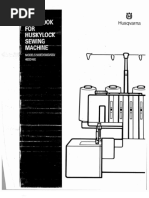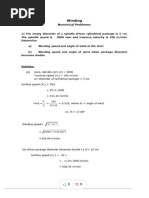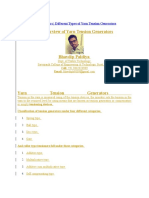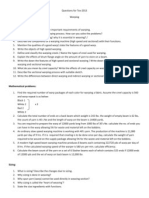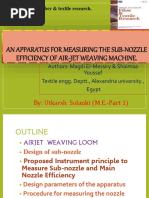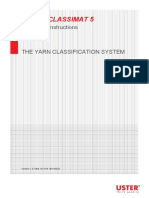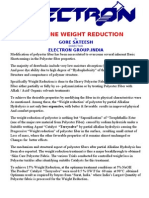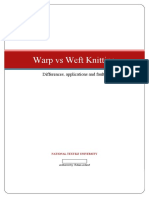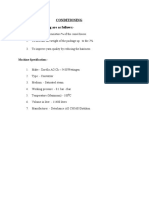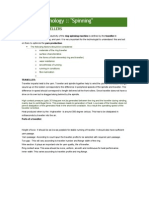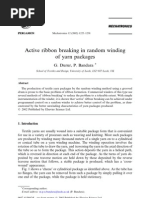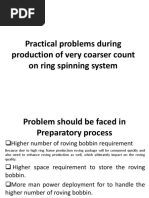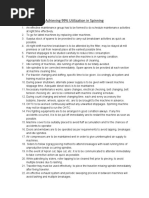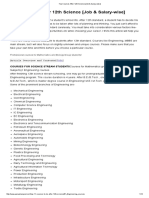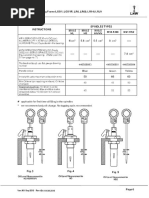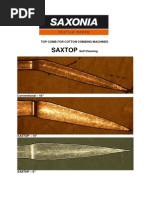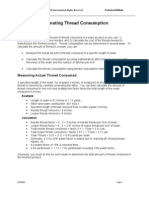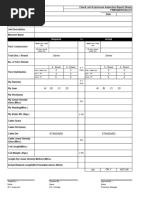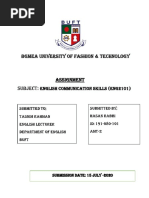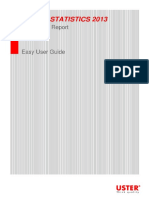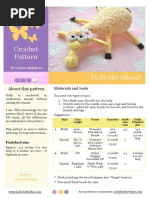32 Winding
32 Winding
Uploaded by
Venkat PrasannaCopyright:
Available Formats
32 Winding
32 Winding
Uploaded by
Venkat PrasannaOriginal Description:
Copyright
Available Formats
Share this document
Did you find this document useful?
Is this content inappropriate?
Copyright:
Available Formats
32 Winding
32 Winding
Uploaded by
Venkat PrasannaCopyright:
Available Formats
1
Yarn Preparation (Winding)
Process/processes of preparing the yarn produced on the
spinning machine to meet the requirements of subsequent
processes, such as weaving, knitting and yarn dyeing
Clearing, winding and waxing are usually performed on
one machine: WINDER
Objecti ves of yarn preparation
Clearing: fault removal
Winding: transferring yarn from one package form to another
Yarn treatments: e.g. waxing, steaming and conditioning
Warping: preparing the warp package (beam)
Sizing: mainly for preparing the warp for weaving
Yarn must not be damaged during winding
Winding requirements
Yarn fault must be reduced to the required level
Yarn tension must be appropriate and as
uniform as possible
Package size, shape, build must meet the
requirements of the next process
Package types
Cylindrical
Cheese (with / without flange)
Pineapple cheese
Pirn
2
Cone
Package requirements
Size
Density
Stability
Unwinding performance
Package Build
Parallel build
High density
Unwinding is restricted
Flange is often required
Low stability
Parallel Built Package
With Taper (Roving)
Cross wound (quick traverse)
Lower density
Better stability
Large fluctuation of unwinding tension
Compromise of density and ease of withdraw
(shorter traverse length)
Chase build (progressi ve conical traverse)
3
Main layer
(slow lifting of ring rail)
Ring Package (Cop)
Tube
Cross layer
(fast descending)
Package building
motion
tD
D
Basic theory of winding
Angle of wind (two definitions)
Angle between yarn and package axis
Angle between yarn and any plane perpendicular to
the package axis
u
u
Vt
DpNp
Vt
Vp t
u = = Tan
Winding speed
u
Np
Vp
Vt
Vw
Dp
2 2
Vt Vp Vw + =
Angle between yarn and package axis
Effects of Angle of Wind
Package Density
Minimum Density at 45
o
Maximum Density at 90
o
(Parallel Wound)
Effects of Angle of Wind
Package Density
Package Stability
Maximum ~ 80
o
4
If winding angle is too large,
coil pitch can be too small on tube (small D),
increasing risk of yarn entanglement
C
o
il p
it
c
h
Effects of Angle of Wind
Package Density
Package Stability
Traverse speed
Power consumption
Acceleration force on yarn guide
Normal range: 70
o
~80
o
(limit depends on yarn type and winding speed)
Vt
Vp
= u Tan
Number of yarn coils wound on package during one
single traverse (from one end of package to other end)
Wind
Number of yarn coils wound per complete traverse
cycle (from one end of package to other end and back)
Traverse ratio
It is twice the wind
Nt = Vt / 2Lt
Lt = traverse length
Vt = traverse speed (ignoring reversal effects)
If
Number of double traverses per minute
(traverse rate):
Lt
Traverse ratio Tr = Np/Nt
Traverse Ratio:
Number of Yarn Coils per Cycle (Double Traverse)
5
Tr = 10
Tr = 5
Patterning (Ribboning)
Repeated winding of yarn at exactly the same
place on the package during successi ve
double traverses
Patterning causes
Poor unwinding performance
Uneven colour in dyeing
Traverse Rati o=3 Traverse Rati o=2.5
The yarn will return to its starting point
after n double traverses
With a traverse ratio of w +m/n
w, m and n are integers
m < n
m and n have no common factors
5-1/15 5-1/20 5-1/37 5-1/43 5-1/68 5-1/1000 5+77/10000
6
Traverse method
Reciprocating yarn guide
Traverse method
Reciprocating yarn guide
Characteristics
Speed limited by inertia
Flexible in package formation
No appreciable twist displacement
Grooved Drum
Traverse method
Mainly used for spun yarns
Grooved drum
Characteristics
Usually also act as package drive roller
No inertia problems
Lower energy consumption
Less maintenance cost
More twist displacement
More yarn abrasion by drum
Higher tension is required
Traverse method
Rotating blades
Traverse method
7
Not widely used
Rotating blades
Characteristics
No inertia problem
Flexible package formation
Blades can cause yarn damage
Blades may lose control of yarn at
reversal points, causing traverse
length variation
Traverse method
Package drive
Friction drum
Not suitable for yarns with
low abrasion resistance
Direct drive
Constant rotational speed
(wide application)
Constant surface speed
(expensive)
Traverse ratio decreases
Random winding
Package surface speed (Vp)
and
Traverse speed (Vt or Nt)
are constant
Since tanu = Vp / Vt
Angle of wind is constant
But Np = Vp / tDp
Dp increases
Np decreases
During winding
Tr = Np / Nt
Tr =Np/Nt =Vp/tDpNt
Smaller Dp Faster Tr changes
But package diameter Dp increases
So package surface speed
Vp=tDpNp increases
And
tan u = Vp/Vt increases
Precision Winding
Package rotational speed (Np)
And traverse rate (Nt) are constant
Tr = Np/Nt
Traverse ratio is constant
So winding angle increases
8
Combination of precision winding and random winding
Some general aspects of precision winding
Package drive (constant Np)
Patterning (avoided by suitable traverse ratio)
Limited package diameter (winding angle/speed)
Variable production rate
Close-winding and open-winding
Close Wind Open Wind
The magnitude of the gain determines how close to each
other yarn coils from successive double traverses will be
Precision Winding
Gain
If the traverse ratio is w + z
where w is an integer
Yarn coil from successive layers
will be displaced by z revolutions
z is the gain
Gain can be positive or negative
tDp
Lt
y
Dp/2
y=tzDp
y=d/cosu
Traverse Ratio=2+z
y
u
z
d
u
u y
d
Z = y/(tDp) = d/(tDpCosu)
For close winding:
Yarn diameter (count, twist, fibre type)
Package diameter
Winding angle
The gain required for close winding depends on
Z = d/(tDpCosu)
The loss of traverse length at high
package speeds
Limits of winding speed
The inertia of the yarn guide (Nt ~ 450 d.t./min)
The traverse ratio (Tr = Np/Nt)
The angle of wind (70
o
~ 80
o
)
The textile limit imposed by the yarn
(~1200 m/min for spun yarns)
Winder speed can be much higher
Vt
Vp
= u Tan
9
Short term tension variation
Cheese: length of thread path varies from
the middle to the ends of package, causing
speed variation and tension variation
Cone: yarn speed varies along package length
Short term tension variation
Cheese: length of thread path varies from
the middle to the ends of package, causing
speed variation and tension variation
Cone: yarn speed varies along package length
Short term tension compensators
Short term tension variation
Cheese: length of thread path varies from
the middle to the ends of package, causing
speed variation and tension variation
Tension Control
Yarn tension must be controlled within limits
for good package formation, correct package
density and minimum yarn damage
10
Over-end Unwinding
Unwinding tension
Adds twist
Extra tension is usually applied
Less affected by yarn speed variation
Tension varies as balloon height changes
Friction (low speed: yarn sliding on the surfaces
of tube and package)
Balloon (high speed)
Stationary package
Over-end
Unwinding tension
Side Unwinding
Unwinding tension
Only applicable to high tension winding (e.g. coarse industrial
yarn) and low speed negative let-off systems (e.g. warp supply)
Rotating package
Rotational speed must vary to maintain
constant yarn speed
Positive driven
Negative let-off
Inertia changes with package weight
Acceleration and deceleration cause large tension fluctuation
Package must be retarded
on package surface
on spindle
Package growing at high speed
Yarn tension can not be kept low and regular at high speeds
Side Unwinding
Inexpensive
Tensioner
Easy to thread
Easy to adjust
Yarn tension within specified limits
Unaffected by yarn lubricants, loose fibres and fly
Easy adjustment and self-compensating for wear
Not affecting yarn twist distribution
Device to Increase Yarn Tension During Winding
Requirements
T1
T2
Yarn path
direction
u1
u2
T3
1 1
1 2
u q
e T T =
=
u q
e T T
in out
2 2
2 3
u q
e T T =
2 2 1 1
1
u q u q
e e T =
) (
1
2 1
u u q +
= e T
Tensioning devi ces
a) Friction rods: multiplicative
Magnifies tension fluctuations
11
=
u q
e T T
in out
Example
T
in
= 101 g
10 =
u q
e
T
out
= 10010 g
T2 T1
P
T2 T1
P
T2 = T1+qP
T2 = T1+2qP
b) Tension roller and plate
c) Two tension plates
(b) and (c) are additive
Influenced by
Can cause twist redistribution
and twist variation
dirt accumulation
localised wear
T2 = T1+qP
Example
T
1
= 101 g
T
2
= 1001 g
qP = 90 g
Constant Torque
Pulley Rotates with Yarn
No Slippage
Pulley tensioner
pulley with constant torque
yarn pulls it around without slippage
P
Disk tensioner
combination of additive &
multiplicative principles
12
T1
T2
Tension Compensator
Provide constant winding tension,
independent of unwinding tension
You might also like
- Hagrid CompressedDocument37 pagesHagrid CompressedJuegos Máximo y amara90% (10)
- Princess Haruka 24Document11 pagesPrincess Haruka 24veroromano100% (1)
- Boneca Trolls Poppy by Maria AmelinaDocument23 pagesBoneca Trolls Poppy by Maria AmelinaPaola Fajardo100% (2)
- Aspen LeafDocument7 pagesAspen LeafConnie Slone Corder100% (1)
- Husqvarna Huskylock 460D Sewing MachineDocument33 pagesHusqvarna Huskylock 460D Sewing MachineMarly Salas100% (1)
- Rotor PrincipleDocument12 pagesRotor PrincipleAnkit Balotia67% (3)
- L40 TFO TwistingDocument10 pagesL40 TFO TwistingLalit Kashyap100% (1)
- Cost Structures of Comparable Rotor-Spun and Ring-Spun Yarns - RieterDocument3 pagesCost Structures of Comparable Rotor-Spun and Ring-Spun Yarns - RieterVenkat Prasanna100% (1)
- Cost Working SheetDocument10 pagesCost Working SheetRajveer Veer100% (1)
- Yarn Winding: by M. Naveed AkhtarDocument29 pagesYarn Winding: by M. Naveed Akhtarfatimasajjad354100% (1)
- 23 Ring 3Document9 pages23 Ring 3jdjprabhuNo ratings yet
- Winding Math For Preparation of The Exam - CompressDocument10 pagesWinding Math For Preparation of The Exam - CompressHưng HoàngNo ratings yet
- Mathematical Approach For The Yarn Pressure in Bobbin Winding PDFDocument4 pagesMathematical Approach For The Yarn Pressure in Bobbin Winding PDFEduardoNo ratings yet
- Yarn Manufacturing Tandem CardingDocument5 pagesYarn Manufacturing Tandem CardingIndrajit BoseNo ratings yet
- Welcome To Our PresentationDocument40 pagesWelcome To Our PresentationAbdul AzizNo ratings yet
- Carding Drawing Math 2Document3 pagesCarding Drawing Math 2Ratul DriveNo ratings yet
- Weaving Technology LEC1Document10 pagesWeaving Technology LEC1Suza Ahmed AuporboNo ratings yet
- Cost Analysis: Quality Comes First, Rest Are ConsequencesDocument5 pagesCost Analysis: Quality Comes First, Rest Are ConsequencesAl AminNo ratings yet
- Coolmax BlendsDocument2 pagesCoolmax BlendsErik Valentin BergströmNo ratings yet
- Yarn Tension Generators Different Types of Yarn Tension GeneratorsDocument5 pagesYarn Tension Generators Different Types of Yarn Tension GeneratorsMohammed Atiqul Hoque ChowdhuryNo ratings yet
- Airjet PracDocument12 pagesAirjet PracJunaid SuhailNo ratings yet
- Blowroom 2Document27 pagesBlowroom 2Abhi ParamNo ratings yet
- Questions For Tex-2013Document2 pagesQuestions For Tex-2013Emdad SarkerNo ratings yet
- Fabric Manufacturing I-UnlockedDocument30 pagesFabric Manufacturing I-UnlockedDheerajNo ratings yet
- Fiber FinenessDocument7 pagesFiber FinenessFahima RashidNo ratings yet
- Warp Knitting:: Basic Warp Knit StructureDocument21 pagesWarp Knitting:: Basic Warp Knit Structuremike workuNo ratings yet
- Spin Plan-Existing RFDocument1 pageSpin Plan-Existing RFardhendu1No ratings yet
- Yarn Preparation For Weaving IDocument18 pagesYarn Preparation For Weaving IKathirrveluSubramainan0% (1)
- Nptel TT 9Document28 pagesNptel TT 9Kamal SahuNo ratings yet
- Carding TheoriesDocument2 pagesCarding TheoriesVaibhav K Dhange50% (2)
- Nozzle EfficiencyDocument32 pagesNozzle EfficiencyGOWTHAM CHANDRUNo ratings yet
- Concept of High Volume Instrument (HVI) HVI Used in Bale MDocument15 pagesConcept of High Volume Instrument (HVI) HVI Used in Bale MS.m. MahasinNo ratings yet
- Textile Engineering and Fibre ScienceDocument3 pagesTextile Engineering and Fibre ScienceNikhil TakbhateNo ratings yet
- Training Report of Gcti Tarinees MS WORDDocument55 pagesTraining Report of Gcti Tarinees MS WORDAakash NagpalNo ratings yet
- Beat UpDocument10 pagesBeat UpAsifur RahmanNo ratings yet
- 08-Weft Knitting (Circular) PDFDocument53 pages08-Weft Knitting (Circular) PDFDAWOOD MALIKNo ratings yet
- Ring SpinningDocument11 pagesRing SpinningShahid MahmoodNo ratings yet
- Beat Up 2Document37 pagesBeat Up 2thebiggestarcheroflvl2No ratings yet
- Fabric TestingDocument24 pagesFabric Testingjob wabwire100% (1)
- Classimat 5 HelpDocument214 pagesClassimat 5 HelpPoint To Point100% (1)
- Uster Statistics-50s CBD Compact ConeDocument6 pagesUster Statistics-50s CBD Compact Coneselvapdm100% (1)
- Unit 2Document76 pagesUnit 2Vaibhav SinglaNo ratings yet
- Core Spun Yarn - ProductionDocument8 pagesCore Spun Yarn - Productionjim lovehiowtNo ratings yet
- Alkaline Weight ReductionDocument1 pageAlkaline Weight Reductionsateeshgore100% (2)
- A Operator's Manual Beam Creel BC - ADocument23 pagesA Operator's Manual Beam Creel BC - AvikiNo ratings yet
- Rapier MotionDocument9 pagesRapier MotionuxmaNo ratings yet
- Warp Vs Weft KnittingDocument5 pagesWarp Vs Weft KnittingLinh NguyenNo ratings yet
- Plain WeaveDocument8 pagesPlain Weaveghosh7171No ratings yet
- Core SpunDocument39 pagesCore SpunSadia TabassumNo ratings yet
- Objects of Conditioning Are As FollowsDocument7 pagesObjects of Conditioning Are As FollowssachinnmimsNo ratings yet
- Textile Technology:: "Spinning": Rings and TravellersDocument10 pagesTextile Technology:: "Spinning": Rings and TravellersKuldeep SinghNo ratings yet
- Yarn Winding MethodsDocument6 pagesYarn Winding MethodsCNJSWAMINo ratings yet
- Recent Development of Modern Spinning and WeavingDocument20 pagesRecent Development of Modern Spinning and WeavingsuganNo ratings yet
- 3,4. Slub YarnDocument2 pages3,4. Slub Yarnshahadat hossainNo ratings yet
- 02 Winding PDFDocument41 pages02 Winding PDFDAWOOD MALIKNo ratings yet
- TFO Textile MachinesDocument8 pagesTFO Textile MachinespothigaiselvansNo ratings yet
- BITPonlinetest SampleQuestionsDocument3 pagesBITPonlinetest SampleQuestionsAnkur Bhatia0% (1)
- Fibre MigrationDocument5 pagesFibre MigrationAbd. Alim100% (1)
- Moisture Transmission Through Textiles 1Document11 pagesMoisture Transmission Through Textiles 1Ahmad SamerNo ratings yet
- Introduction To Textile Fabric Part 3: Double Knit StructuresDocument20 pagesIntroduction To Textile Fabric Part 3: Double Knit StructuresNauval AsshNo ratings yet
- Blowroom: Basic Operations in The BlowroomDocument3 pagesBlowroom: Basic Operations in The BlowroomIndu VikasiniNo ratings yet
- 15T404 Fabric Manufacture I: Warp WindingDocument45 pages15T404 Fabric Manufacture I: Warp WindingPrabhakaran JNo ratings yet
- Learn Textile0Document208 pagesLearn Textile0Hassan ShahzadNo ratings yet
- Active Ribbon Breaking in Random WindingDocument14 pagesActive Ribbon Breaking in Random WindingVaibhav GandhiNo ratings yet
- Wool 482 582 08 T 14 PDFDocument16 pagesWool 482 582 08 T 14 PDFNazmul-HassanNo ratings yet
- Problem Due To Production of Courser CountDocument10 pagesProblem Due To Production of Courser CountPawan KumarNo ratings yet
- Oerlikon Manmade Fibers Teknoweb MedienmitteilungDocument3 pagesOerlikon Manmade Fibers Teknoweb MedienmitteilungVenkat PrasannaNo ratings yet
- Achieving 99% Utilization in SpinningDocument2 pagesAchieving 99% Utilization in SpinningVenkat PrasannaNo ratings yet
- PSG College of Arts & Science Coimbatore - 641 104Document8 pagesPSG College of Arts & Science Coimbatore - 641 104Venkat PrasannaNo ratings yet
- TC 20efDocument2 pagesTC 20efVenkat PrasannaNo ratings yet
- Barre Causes and PreventionDocument19 pagesBarre Causes and PreventionReal SheriffNo ratings yet
- KolukkumalaiDocument5 pagesKolukkumalaiVenkat PrasannaNo ratings yet
- Asg enDocument2 pagesAsg enVenkat PrasannaNo ratings yet
- Top Courses After 12th Science (Job & Salary-Wise)Document13 pagesTop Courses After 12th Science (Job & Salary-Wise)Venkat PrasannaNo ratings yet
- LMW Recommendation in Instruction Manual R 123 - New RecommendationDocument2 pagesLMW Recommendation in Instruction Manual R 123 - New RecommendationVenkat PrasannaNo ratings yet
- Top Comb For CombersDocument5 pagesTop Comb For CombersVenkat PrasannaNo ratings yet
- Sitra Janfeb2015newsDocument22 pagesSitra Janfeb2015newsVenkat PrasannaNo ratings yet
- Spinning Packing DensityDocument14 pagesSpinning Packing DensityVenkat PrasannaNo ratings yet
- Extraction Productionof Agro Sackfrom Banana Musa Sapientum Plantain Musa Paradisiacal Fibresfor Packaging Agricultural ProduceDocument7 pagesExtraction Productionof Agro Sackfrom Banana Musa Sapientum Plantain Musa Paradisiacal Fibresfor Packaging Agricultural Producetolera456No ratings yet
- Pre-Treatment - ClasssDocument202 pagesPre-Treatment - ClasssAbel TayeNo ratings yet
- Dyeing of Blends: Submitted To-Submitted byDocument32 pagesDyeing of Blends: Submitted To-Submitted byMehak Deep75% (4)
- Crochet Now Magazine - Issue 12, 2017 PDFDocument102 pagesCrochet Now Magazine - Issue 12, 2017 PDFCris Ela100% (11)
- Chemical Testing DyeingDocument23 pagesChemical Testing DyeingMah Gul100% (1)
- ProductsDocument6 pagesProductsapi-3733260No ratings yet
- Thread ConsumptionDocument4 pagesThread ConsumptionMd Mamun Hosain100% (1)
- BNBX1506 PDFDocument16 pagesBNBX1506 PDForpheus292% (13)
- WeavingDocument15 pagesWeavinginayahaq81No ratings yet
- Check ListDocument1 pageCheck ListSwapnil KumarNo ratings yet
- Impact of COVID-19 On BusinessDocument8 pagesImpact of COVID-19 On BusinessHasan RabbiNo ratings yet
- DLL q1 Week 7 HandicraftDocument13 pagesDLL q1 Week 7 Handicraftroenna.simpao37No ratings yet
- Tulip CheliDocument8 pagesTulip CheliEsther Ramirez100% (1)
- Flower ScarfDocument2 pagesFlower Scarfsmqh2tryr8No ratings yet
- Principles of EvidenceDocument159 pagesPrinciples of EvidenceLhine Kiwalan100% (2)
- Uster Quantum ClearerDocument27 pagesUster Quantum ClearerMd. Humayun KabirNo ratings yet
- F2 Dolly The Sheep English v14 SmallDocument11 pagesF2 Dolly The Sheep English v14 SmallJosé Eduardo Gonzalez100% (3)
- Fox - and - Dog Best FriendDocument45 pagesFox - and - Dog Best Friendveronej1992100% (7)
- Fabric Structure DesignDocument47 pagesFabric Structure DesignAhmed100% (1)
- Crochet Pumpkin SweetsDocument41 pagesCrochet Pumpkin Sweetsdanilmeonis100% (8)
- Guides For TextileDocument67 pagesGuides For TextileTOXIC SIDNo ratings yet
- Revista MiniaturasDocument73 pagesRevista MiniaturasViviana Jáuregui100% (4)
- Double-Head Draw Frame SB-D 22: AdvantagesDocument24 pagesDouble-Head Draw Frame SB-D 22: AdvantagesMuhammad Farooq KokabNo ratings yet
- Amigurumi MF KingDocument8 pagesAmigurumi MF KingKaren Opazo TorresNo ratings yet




